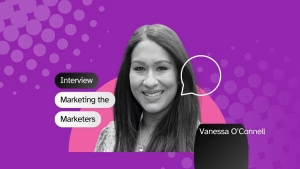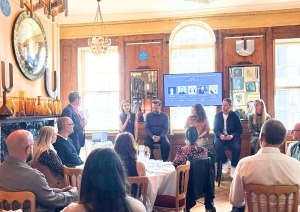When it comes to media, the consumer is spoilt for choice. But as the publishing sector has become ever-more crowded, it’s becoming hard than ever to stand out. It’s survival of the fittest – and the best at making an impact.
At its latest Marketing the Marketers event, NDA hosted an exclusive panel to discuss how publishers can make an impact in the market by securing the most effective partnerships and playing to their strengths.
Media is a precarious business. One day, you can be a media darling, not just capturing the zeitgeist but leading it. The next, layoffs and shutdowns are the order of the day. To withstand the buffeting headwinds of trend and favour, media brands have to make sure they stay ever relevant to their audiences, growing their share and building trust within their communities.
At the latest Marketing the Marketers event, moderator and New Digital Age editor, Justin Pearse, led four senior publishing executives in a discussion around how best to stand out in such a noisy marketplace. On the panel were Gideon Spanier, Editor in Chief of Campaign, George Butler, Head of Commercial Marketing, Bauer, Jessica Lester, Partnerships Director at OMD EMEA and Quentin Ranson, Marketing Activation Director for Levis.
Typically used to being on the other side of the PR fence, the panel dove right into the tricky issue of self-promotion and why it’s important to attract attention. Levi’s Quentin Ranson kicked off the discussion by noting that size isn’t necessarily what gets you noticed or trusted. “You don’t have to be the biggest publisher but it’s about what your access to the audience is and the extra authority you have with them that we as a brand cannot have.”
One person used to covering the publishing industry is Campaign’s Gideon Spanier. He revealed what it was he was looking for as an editor. “There could be a number of reasons why a publisher might be newsworthy and some of that narrative you don’t really control. It could be as simple as your financial results.”
He continued: “When it comes to campaigns, nothing beats a phone call or a well-constructed email but it’s got to stand out. Building relationships is important.” Spanier adds that it’s important for publishers to get out there and have their voices heard, not least because of the crucial service they provide to their communities in also letting them have a voice in a crowded market. “Diversity and inclusion has risen up the agenda and going to the top five as a default is sometimes the wrong thing to do. We need to talk about minority media and what else is out there.”
Just because the audience is there, it doesn’t mean their attention should be taken for granted. Bauer’s George Butler describes how he has had to battle for his audience: “Ours is not an easy audience to reach, we have to be very strategic in the message we want to get across. How are we going to be memorable?”
Memorable means not being afraid to play the platforms at their own game, suggests OMD EMEA’s Jessica Lester. She describes Dove’s latest campaign on TikTok. “It was based on such a strong insight around a TikTok beauty filter that had been used around 300 million times. They did a campaign around not using a filter. They weren’t afraid to be a bit disruptive on the platform and it wasn’t pushing product, just relating to their purpose.”

Ranson agrees that contrasts can be powerful: “The recent Vogue/Snapchat exhibition was a great example of how a traditional publisher can partner with a tech company, using all the new technology but in a way that makes sense and adds value for the end consumer.”
Purpose has generally been seen as one way to get genuine and deeply felt engagement but it’s not a given and sometimes, publishers hope that the simple fact they’re aligned with a purpose will do all the legwork. “Running a lot of awards, I see a lot of entries but sometimes I just want to go and find out how companies are presenting themselves,” Spanier suggests. “There can be lots of different ways that they’ll come to us and sometimes an email is good but if there’s more depth, that’s helpful because it’s frustrating to be pitched something you think is very shallow.”
Butler gives the example of the Mental Health Minute that ran while he was at Radiocentre. He explains that the campaign’s power came from collaboration and its sheer scope, involving every radio station in the UK. “ It was beyond advertising, primarily for the audience. It would blow our minds how, every year, it would grow and grow, getting more media attention. It was a really good example of doing something for the right reasons.”
Spanier agrees that this is an example of publishing purpose done right: “This is why genuine collaboration is so important, it leads to better results, particularly around purpose.”
While it’s so tempting to follow a well-trodden path, it doesn’t hurt to mix it up a bit when it comes to purpose, and attempt to work on less (initially) receptive audiences. “Quite often I’ve been working on a purpose-led brief and aligning with partners, what is more impressive is when a partner comes back and says that half their audience doesn’t really agree with the message,” reveals Lester. “That can be a risky approach but it’s also an opportunity because why preach to the converted. Don’t be afraid to say that your audience might not be aware of the purpose piece you want to drive.”
Risk-taking is certainly something that can reap rewards but understandably keeps marketers up at night. Perhaps they’re better qualified as ‘calculated risks’. “Our biggest campaign was educating consumers that, if you buy quality jeans, you can have one pair instead of 10 and wear them longer. It was a huge sustainability message and it took courage to say ‘buy less’,” Ranson admits.
However good your story, or worthy your purpose, it pays not to be lazy. Just because it’s a good idea don’t expect the press to start knocking your door down. “Don’t wait for people to tell your story to be visible,” Spanier warns. “It requires a degree or relentlessness. And it’s not the person who shouts loudest that gets heard, but instead being targeted and persistent. You can’t just do it all remotely, that’s not how journalism works. People respond to confidence and that comes if you’re visible.”










